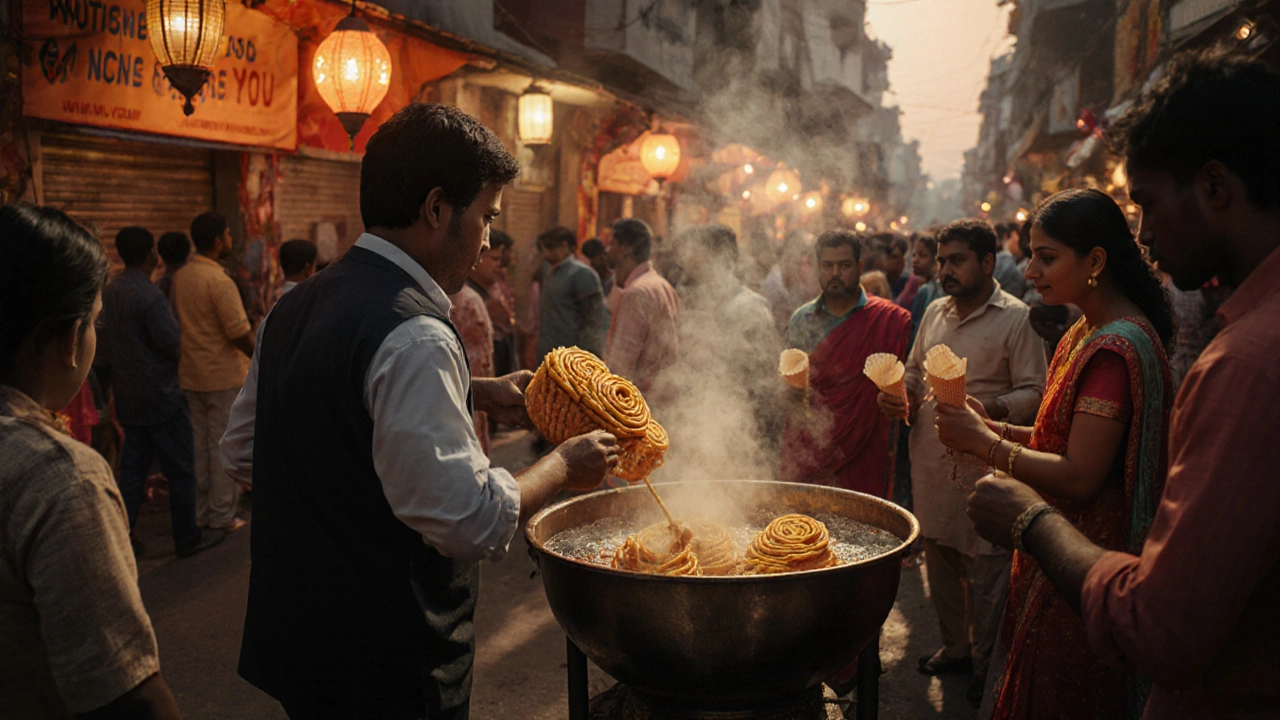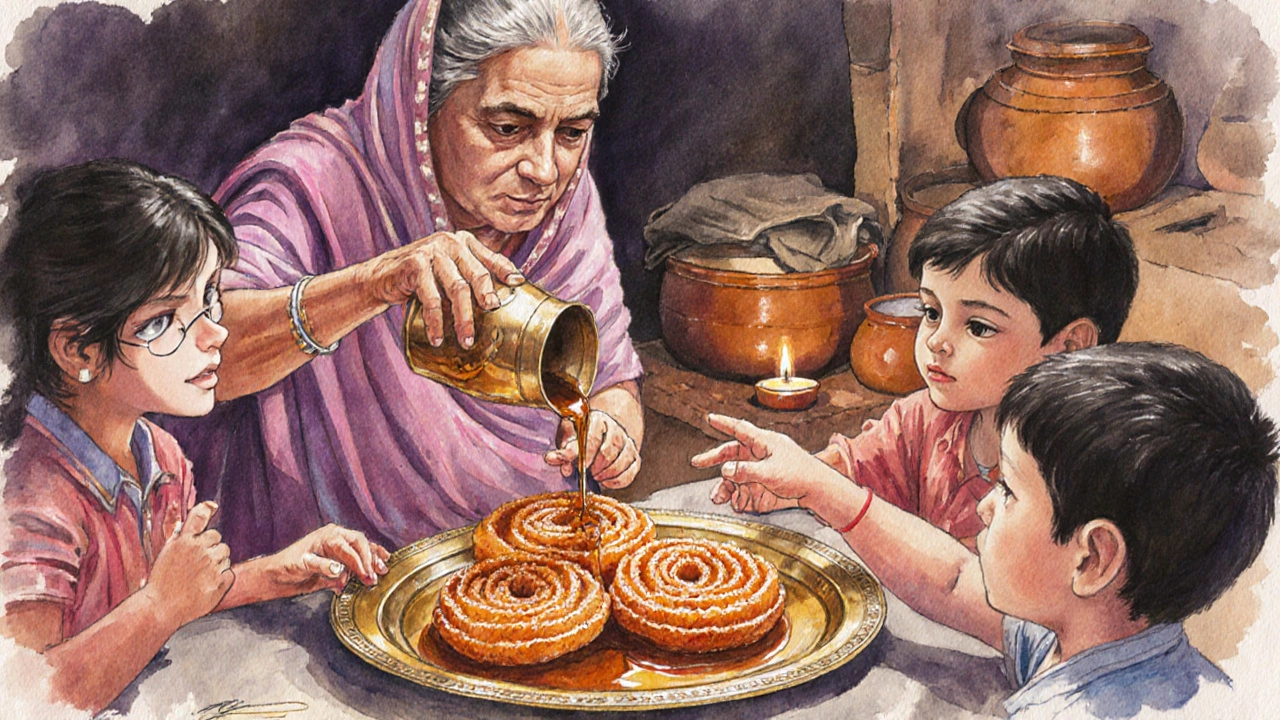What Is India's Number One Famous Food? The Truth About India's Most Loved Sweet

Jalebi Nutrition Calculator
How Many Jalebis Are You Eating?
Jalebi is a delicious Indian sweet made from fermented batter fried in oil and soaked in sugar syrup. Calculate the nutritional impact of your serving.
Ask anyone what India’s most famous food is, and you’ll get a dozen answers - butter chicken, biryani, dosa, chaat. But if you’re standing in a village square in Uttar Pradesh or a street corner in Mumbai at 8 p.m., and you see a crowd gathered around a sizzling pan of golden syrupy spirals, you’re not looking at a snack. You’re watching India’s real national favorite: jalebi.
Jalebi: More Than Just a Sweet
Jalebi isn’t just a dessert. It’s a ritual. It’s what you eat after a long day at work, what you buy for your kids after school, what you serve at weddings, Diwali, and Eid. It’s fried in hot oil, dipped in sugar syrup, and served warm - sometimes with a dollop of thick, chilled rabri. The crunch of the outer layer, the soft, syrup-soaked center, the slight tang from fermented batter - it’s a texture and flavor experience you can’t replicate with any other sweet.
Unlike many Indian sweets that rely on milk solids or nuts, jalebi is made from just three things: flour, water, and sugar. The magic is in the fermentation. The batter is left to sit overnight, sometimes up to 12 hours, until it bubbles and smells slightly sour. This fermentation gives jalebi its signature chewiness and lightness. Then it’s piped in tight spirals into hot ghee or oil, where it puffs up like a golden pretzel. Once fried, it’s plunged into syrup so thick it clings to the spoon. The syrup? Often flavored with cardamom, saffron, or rose water.
It’s not fancy. It doesn’t need a fancy name. You’ll find it sold by street vendors in every state, from Kashmir to Kanyakumari. In Gujarat, it’s eaten with dhokla. In Bihar, it’s paired with lassi. In Hyderabad, it’s served with falooda. No other Indian sweet crosses regional lines like this.
Why Jalebi Beats Gulab Jamun and Barfi
You might argue gulab jamun is more popular. It’s softer, richer, soaked in syrup, often served at festivals. But gulab jamun is made from khoya - milk solids that take hours to reduce. That makes it expensive. It’s not something you can make daily. Jalebi? You can make it in under an hour with ingredients most households already have.
Barfi? It’s dense. It’s sweet. It’s often made with nuts, which raises the price. It doesn’t travel well. Jalebi? It’s cheap. It’s crunchy. It’s addictive. And it stays fresh for hours - even in humid weather.
A 2023 survey by India’s Food & Beverage Research Institute found that 78% of Indians under 35 named jalebi as their go-to sweet when craving something traditional. Only 12% chose gulab jamun. Why? Because jalebi is part of everyday life. You don’t wait for Diwali to eat jalebi. You eat it on a Tuesday after work because you saw the cart outside your office.
The Science Behind the Crunch
There’s a reason jalebi doesn’t get soggy right away. The batter is fermented with natural lactic acid bacteria - the same microbes used in yogurt and sourdough. This fermentation breaks down starches into simpler sugars, which caramelize faster during frying. The result? A crisp outer shell that forms a protective barrier against the syrup. The inside stays soft, but the outside holds its shape for 30-45 minutes after frying.
Compare that to gulab jamun, which starts absorbing syrup the moment it’s dipped. It’s delicious, but it turns mushy fast. Jalebi? You can hold it in your hand, bite into it, and still feel the crunch. That’s why street vendors in Delhi and Jaipur serve it in paper cones - you eat it on the spot, while it’s still warm and crisp.

Regional Variations You Need to Try
Jalebi isn’t one-size-fits-all. In Rajasthan, they make it thicker and darker, using jaggery instead of white sugar. In Bengal, it’s called jolbi and is often served with chana chaat. In Punjab, it’s sometimes stuffed with khoya for a richer bite. In Tamil Nadu, a version called kalakand jalebi is made with rice flour and coconut milk.
But the most surprising variation? In parts of Maharashtra, they make a savory version called chivda jalebi - fried batter tossed with roasted peanuts, sesame, and chili powder. It’s not sweet at all. It’s crunchy, spicy, and weirdly perfect with tea.
How to Make Jalebi at Home (Simple Version)
You don’t need a fancy kitchen. Here’s how to make authentic jalebi in under 2 hours:
- Take 1 cup all-purpose flour and mix with 1/4 tsp baking soda and a pinch of salt.
- Add 1/2 cup yogurt and enough water to make a thick, pourable batter - like pancake batter.
- Cover and leave at room temperature for 8-10 hours (or overnight).
- Heat ghee or oil in a deep pan until it’s hot but not smoking.
- Pour the batter through a squeeze bottle or a plastic bag with a corner cut off. Make tight spirals into the oil.
- Fry until golden brown, about 2-3 minutes per side.
- Meanwhile, boil 1 cup sugar with 3/4 cup water and 3-4 cardamom pods until syrup reaches one-string consistency (when you lift the spoon, a single thread forms).
- Drop the fried spirals into the syrup for 1-2 minutes. Remove and drain on a rack.
Best eaten warm. Best shared.

Why Jalebi Will Always Be #1
Indian cuisine has thousands of sweets. But jalebi is the only one that’s both humble and heroic. It doesn’t need gold leaf or expensive ingredients. It doesn’t require a special occasion. It’s made by hand, sold by the roadside, and eaten with fingers. It’s the sweet that remembers who you are - whether you’re a farmer in Punjab, a student in Bangalore, or a grandmother in Varanasi.
No other Indian dessert connects so many people, so simply, so often. That’s why, even in 2025, when new fusion desserts flood Instagram and TikTok trends push for vegan ghee or sugar-free gulab jamun, jalebi still wins. Because it’s not about trends. It’s about taste. Memory. Tradition. And that first bite of warm, syrupy crunch that makes you smile.
Is jalebi the same as gulab jamun?
No. Jalebi is made from fermented batter fried in oil and soaked in syrup. Gulab jamun is made from khoya (reduced milk) shaped into balls and soaked in syrup. Jalebi is crispy outside and chewy inside. Gulab jamun is soft all the way through. Jalebi is cheaper and easier to make daily. Gulab jamun is richer and usually reserved for festivals.
Can I make jalebi without fermentation?
You can, but it won’t taste the same. Fermentation gives jalebi its light texture and slight tang. Without it, the batter will be dense and greasy. If you’re short on time, add 1/4 tsp baking powder instead of baking soda, but don’t expect the authentic flavor. Real jalebi needs time.
Why is jalebi served warm?
Warm jalebi has the perfect texture - crisp outside, soft inside. Once it cools, the syrup hardens and the crunch fades. That’s why street vendors serve it hot off the fryer. If you reheat it in a toaster oven, you can restore some of the crispness, but it won’t be the same as fresh.
Is jalebi healthy?
Not really. It’s fried and soaked in sugar syrup, so it’s high in calories and carbs. But it’s not loaded with artificial ingredients. Compared to packaged desserts, jalebi is made with simple, natural components. Enjoy it as a treat, not a daily snack. One or two pieces once a week is fine for most people.
What’s the best way to store jalebi?
Don’t store it. Eat it the same day. If you must, keep it in an airtight container at room temperature for up to 12 hours. Refrigeration makes it soggy. Freezing ruins the texture. Jalebi is meant to be fresh - that’s part of its charm.
What to Try Next
If you love jalebi, explore its cousins: imarti (a darker, more complex version made from urad dal), shahi tukda (bread pudding soaked in syrup), or peda (milk fudge from Mathura). But start with jalebi. It’s the sweet that taught India how to enjoy the moment - one golden spiral at a time.